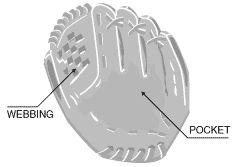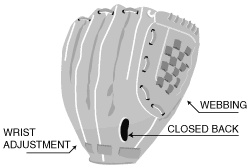How To Buy A Baseball Glove
Gloves, like the hands they fit, come in a variety of sizes. Baseball and softball gloves also are geared to fit both the position you play and the level of your game. Keep these factors in mind when you decide which style, size, features and materials best suit your game.
- Gloves by Fielding Position
- Catcher
- First base
- Infield
- Outfield
- Softball
- Find the Features that Fit Your Game
- Construction
- Materials
- Fit the Glove to Your Hand
- Buying a Ball
- The basic ball
- Materials
- Gloves by Fielding Position
Gloves are made to better help you field your position. A key element in determining the size mitt you buy is the position you play in the field.
Catcher
- A fingerless mitt (it does not have individual fingers)
- Has heavy padding to reduce the sting from the pitcher's throw
- Reinforced to withstand the heavy use throughout a game
- First base
- Also resembles a mitten, but has less padding than the catcher's mitt
- It is longer to help the first baseman field throws from infielders
- A shallow pocket allows the first baseman to quickly retrieve the ball from the mitt
- Infield
- A five-fingered glove with a shallow pocket
- A youth size is between 9 - 11 inches
- Adults 10 1/2 to 11 1/2 inch is the typical baseball size
- Softball infielder gloves have a deeper pocket to accept the bigger ball
- Second basemen need a smaller glove to help make those quick throws while still having control
- Shortstops use something in the middle for grounders and quick throws
- Third basemen need a larger glove
- Outfield
- Usually sized at 12 to12 1/2-inches for adults, about 11 inches for children
- A deeper pocket to handle balls hit high in the air
- Longer length to give as much reach as possible
- If you plan to play several positions, find a glove that provides the most control for a variety of outfield positions
- Softball gloves
- Generally larger both in the pocket and length to help players handle the larger ball
- If you play both baseball and softball, and you only want to buy one glove, select a softball glove
- Find the Features that Fit Your Game
Today's gloves have different features built-in to help your game and to suit your ability. Here are the key features constructed into gloves and what to consider in finding the glove that suits you.


Construction
- The size of the pocket depends on your position
- Shallow pockets really help middle infielders quickly grab the ball and throw
- Deeper pockets help outfielders shag down fly balls
- Softball players also need a bigger pocket to catch the bigger ball
- Webbing
- Different styles of webbing are available to either help you better field your position or to fit your preference
- A closed web is preferred for pitchers who want to hide the ball from the batter
- Outfielders and third basemen like the extra support from a closed web
- An open web helps middle infielders get the ball out of their gloves quicker to make throws
- Backs
- There are two choices of backs, open or closed
- The type of back is matter of personal preference, but some styles fit some positions better
- The open back leaves a space open across the glove's back
- Middle infielders prefer this for the flexibility
- Outfielders prefer a closed back with a "finger hole" for extra support
- Wrist adjustment
- Gloves come with an adjustment to keep it snug. Not all gloves have these "fit systems."
- A D-ring fastener allows you to pull on the lacing and make the glove tighter or looser
- A Velcro fastener although it may wear quicker, offers convenience of pulling and adjusting to fit your comfort level
- A Lacing adjustment allows you to loosen or tighten the wrist fastener with leather laces.
- A Buckle system adjusts the glove with a buckle similar to an adjustable hat
- Padding
- The amount of padding in the pocket depends on the position played
- The catcher's mitt has more padding to handle hard throws from a pitcher
- Glove makers have been adding more padding for other positions as well to help players handle the sting of hard-hit balls
- There also may be padding in the wrist area to make the glove more comfortable
- Materials
Gloves come in a variety of materials, with the difference being in the feel and durability.
- Leather
- Materials of choice for gloves
- Leather offers the best comfort, control and feel
- The better the leather, the better the glove
- Treated leather
- Leather is treated and softened with chemicals for faster break-in and increased durability
- Treated leather also reduces the care needed for the glove and helps the glove keep its shape
- Synthetic materials
- A lighter, less-durable material
- Less expensive, good for youngsters
- Won't withstand the wear and tear of playing ball nearly as well as leather
- Fit the Glove to Your Hand
Although age is also a factor, the position you play is the most important consideration in choosing a baseball or softball glove.
Youngsters/Beginners
- Youth models are smaller to help kids maintain control
- Avoid the urge to buy a bigger glove that you'll grow into
- Kids under the age of 8 should stick with a glove from 9 to 11 inches
- Kids from 8 to early teens, consider an 11-inch glove
- Beginners also benefit from the added control that they get from smaller gloves
- High School/ Adult
- Outfielders need 12 to 12 1/2 inch gloves with deeper pockets
- Infielders need smaller gloves (10 1/2 to 11 1/2 inch) with shallower pockets for better control and quicker ball transfer
- Pitchers can go with a slightly larger glove than infielders but still need a small enough glove for fielding and throwing quickly
- Softball players require gloves that are slightly longer in length and deeper in the pocket to help field the bigger ball
|
Determining Your Glove Size |
||
|
Age |
Position |
Glove size |
|
Under 8 |
Infield |
9 inches |
|
Under 8 |
Outfield |
11 inches |
|
9-13 |
Infield |
9-10 inches |
|
9-13 |
Outfield |
11-12 inches |
|
High School/Adult |
Infield |
10 1/2-11 1/2 inches |
|
High School/Adult |
Outfield |
12-12 1/2 inches |
Buying a Ball
Balls come in different sizes, materials and hardness.
- Baseballs are 9 inches in circumference
- Leagues for under-10 year old players may use a slightly larger ball
- All softballs used by FCLL are 11 inches in circumference
Materials
Balls are manufactured out of leather or synthetic leather. There are also safety balls for younger players.
- Leather is used in the Major Leagues and other upper-level leagues
- Synthetic leather is used primarily for balls in the Little League age group and younger
- "Safety balls" are engineered to play like a real ball without the sting of a hard ball. Known as "Reduced Injury Factor" or RIF balls, they roll and bounce like their harder cousins, but don't hurt as much if the player gets hit.
FCLL.ORG
Foster City Little League
Since 1966
